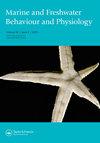室内光照和遮蔽形状影响日本鳗鲡对遮蔽物的选择
IF 0.9
4区 生物学
Q3 MARINE & FRESHWATER BIOLOGY
Marine and Freshwater Behaviour and Physiology
Pub Date : 2018-03-04
DOI:10.1080/10236244.2018.1495547
引用次数: 5
摘要
本研究评估了内部照度和遮蔽形状对日本鳗鱼遮蔽选择的影响,以便为日本鳗鱼保存或建造合适的遮蔽。日本鳗鱼能够分辨出庇护所内照明差异的1.25倍,并且更喜欢较暗的庇护所。当两个相同形状的避难所的内部照度小于环境照度的十分之一(约400 lx)时,即使避难所内部照度相差10倍,日本鳗鱼的避难所选择也不受内部照度的影响。庇护所的宽度并不重要,但日本鳗鱼更喜欢深的庇护所,天花板低,墙壁延伸到“死角”。这对为日本鳗鱼建造合适的庇护所具有重要意义。本文章由计算机程序翻译,如有差异,请以英文原文为准。
Internal illuminance and shelter shape affect shelter selection by the Japanese eel Anguilla japonica
ABSTRACT The present study evaluated the effects of internal illuminance and shelter shape on shelter selection by Japanese eels to enable the preservation or construction of suitable shelters for the Japanese eel. Japanese eels were able to distinguish a 1.25-fold difference in illumination inside the shelters, and preferred darker shelters. When the internal illumination of two shelters with the same shape was less than one-tenth of the ambient illumination (about 400 lx), shelter selection by Japanese eels was not affected by internal illuminance, even when there was a 10-fold difference in internal illumination between shelters. The width of the shelter was not important, but Japanese eels preferred a deep shelter with a low ceiling and walls that spread to a ‘dead end’. This has important implications on the creation of suitable shelters for Japanese eels.
求助全文
通过发布文献求助,成功后即可免费获取论文全文。
去求助
来源期刊

Marine and Freshwater Behaviour and Physiology
生物-海洋与淡水生物学
CiteScore
2.10
自引率
0.00%
发文量
9
审稿时长
>12 weeks
期刊介绍:
Marine and Freshwater Behaviour and Physiology is devoted to the publication of papers covering field and laboratory research into all aspects of the behaviour and physiology of all marine and freshwater animals within the contexts of ecology, evolution and conservation.
As the living resources of the world’s oceans, rivers and lakes are attracting increasing attention as food sources for humans and for their role in global ecology, the journal will also publish the results of research in the areas of fisheries biology and technology where the behaviour and physiology described have clear links to the contexts mentioned above.
The journal will accept for publication Research Articles, Reviews, Rapid Communications and Technical Notes (see Instructions for authors for details). In addition, Editorials, Opinions and Book Reviews (invited and suggested) will also occasionally be published. Suggestions to the Editor-In-Chief for Special Issues are encouraged and will be considered on an ad hoc basis.
With the goal of supporting early career researchers, the journal particularly invites submissions from graduate students and post-doctoral researchers. In addition to recognising the time constraints and logistical limitations their research often faces, and their particular need for a prompt review process, accepted articles by such researchers will be given prominence within the journal (see Instructions for authors for details).
 求助内容:
求助内容: 应助结果提醒方式:
应助结果提醒方式:


